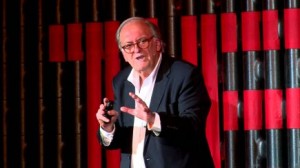|
|
|
|
|
|
|
|
|
|
If you care about the journey and the place, you need a story. If you have a good, compelling one, there will be lots of good people traveling with you.
|
|
|
|
|
|
|
|
|
|
|
|
|
 Corporate grade, reporting lines and membership of leadership teams in organizations often go together. But unbundling these components is a healthy exercise and a powerful rule in the maths of change.
Corporate grade, reporting lines and membership of leadership teams in organizations often go together. But unbundling these components is a healthy exercise and a powerful rule in the maths of change.
If you report to Joe – CEO, Divisional Director or Country Manager – chances are you share this with another eight or ten people who constitute Joe’s management team, executive committee or leadership team. This is what the organization chart says. Most management teams are formed by what the organization chart dictates; by an ‘accidental’ reporting line. Everybody reporting to Joe is de facto a member of his management team.
In medium-sized or large corporations, structures are very often cross- or multi-functional. Imagine a Business Unit composed of a large Sales function, a smaller Marketing function and then a series of support functions such as HR, Finance, Legal, IT and perhaps a very small Strategy Team. The leadership team of that Unit is bound to be composed of the Director of Sales, the Director of Marketing, the Finance Controller, Legal counsel, the Head of IT and the Head of the Strategy Team. I suggest that this happened by default, by the dictation of the organization chart and that nobody ever questioned it.
But a legitimate question may be, “does everybody need to be part of that leadership team?” Many people in business organizations would of course say ‘no’. But the way we sometimes solve the issue is by promotion/demotion. For example, we may say only directors are really part of the management team. This is managing by grade, not by brain and it’s not what I am suggesting.
Grade in the corporate structure (VP, Director, Manager, Head of) should not be a criterion of membership of a particular leadership team. Membership should be by invitation only. And only those who are in a position to add value to the role – whether they are in charge of a large part of the cake or not – should be invited.
It may be that, on reflection, the leadership team of the above Business Unit example should be composed of the Director of Marketing, the Director of Sales, the Head of HR and two Country Managers who do not report directly to the top leader of the Business Unit, but who are called upon to serve on that leadership team.
There may be alternative arrangements, but the principle is one of ‘by invitation only’. A principle that forces you to stop taking for granted the fact that membership will happen automatically or that grade or rank are a form of entitlement. It may be counterintuitive at first, but it is very effective. Much of the counterintuitive aspect comes from the fact that we tend to have pre-conceived ideas about how the organization should work. Sometimes these ideas carry flawed assumptions:
When you question management team compositions for the first time and, de facto, try to unbundle corporate grades, leadership and reporting lines, you will encounter some negative reactions and a few puzzled faces. But once this has been accepted as a legitimate questioning of the status quo, a breeze of healthy fresh air will start to flow through your organization!
Something that you may want to try as a model to follow is the Board of Directors. Though there are some differences between countries, a Board of Directors in public companies is usually composed of a few executives and some non-executive directors, who are either representing some shareholder sector or participating as members in their own capacity, background, experience or particular expertise. We have accepted this kind of designed composition as normal when it comes to the Board, but this is far from common for executive and leadership committees. But there is no reason why you could not mirror this, unless you want to stick to the default position because, “we have never done it like that.”
_________________________________________________
 This article is also featured in my latest book: Camino – Leadership Notes on the Road. [6]
This article is also featured in my latest book: Camino – Leadership Notes on the Road. [6]
The Self-Proclaimed Saviours will never save you since their only intent is their personal success. It happens in society and politics, and it happens in organizations.
Self-Proclaimed Saviours love problems. Without them, how could they save anybody. They love them so much, and they need them so much, that they create them if they don’t exist.
In my previous corporate life, one of my senior colleagues who was a Self-Proclaimed Saviour, was very explicit about this: ‘let them fail’, he used to say, referring to some obvious wrong path taken or decisions of project teams charged with attaining goals worth millions.
Self-Proclaimed Saviours are also very good at withholding information or being economic with the truth. They excel at making themselves indispensable in the system by being the ones who have all the pieces of the puzzle.
Self-Proclaimed Saviours are at home at the Mar-A-Lago School of Deconstruction of the Institutional Fabric. In that school, you learn how to show, painstakingly, that the fabric is rotten so that a substitute must be created by the Saviour, on behalf of ‘the people’, or to save ‘the people’, that is. If that entails the fabrication of ‘alternative facts’ and old fashion propaganda, without even the need for a Ministry of that, well, so be it, that is what is needed.
I have come to believe that many Self-Proclaimed Saviours don’t lie, despite the fact that they can express and defend the most outrageous things. The definition of a lie includes ‘intentional untruth’, ‘deliberate intent to deceive’. But Self-Proclaimed Saviours often believe what they want and need to believe. Truth or lie for them is neither here nor there.
We are not different in organizational life. Our own Mar-A-Lago approach to life hosts a fair number of gratuitous reorganizations which sole purpose is to show that A was bad and B solves the problem. A, needed to be saved, and a new leader does that. That is leadership. OK?
Self-Proclaimed Saviours have a hard time when shown the precarious nature of their supposed indispensability. That even the best Self-Proclaimed Saviours end up in the cemetery, a place according to General Charles De Gaulle ‘full of indispensable people’.
I think that Self-Proclaimed Saviours deserve a Day in the calendar, a dedicated Feast. I propose that to be Ash Wednesday, the first day of Lent in the Christian tradition, before all the fasting and ‘moderation’ starts. On that day, particularly in the Catholic Church, there is an old ritual which involves rubbing ashes on one’s forehead, whilst the priest says ‘Memento, homo quia pulvis es, et in pulverem reverteris. That is, ‘remember, man, you are dust and to dust you will return’.
But, for the Self-Proclaimed Saviours, I would definitely say it in Latin.
________________________________________________________________________________________________
For more thoughts on Leadership, you can purchase my latest book…..
This is a collection of notes on leadership, initially written as Daily Thoughts, which started years ago as a way of talking to himself. Camino, the Spanish for road, or way, reflects on leadership as a praxis that continuously evolves. Nobody is ever a leader. Becoming one is the real quest. But we never reach the destination. Our character is constantly shaped by places and journeys, encounters and experiences. The only real theory of leadership is travelling. The only footprints, our actions. The only test, what we leave behind.
Watch the Camino [8] webinar, where I discuss this book and my thoughts on Leadership.
Visit BOOKS [9] to get your copy from Amazon now!
or
You can now read extracts from Chapter 1 [6].

Let me elevate the question of ‘differentiation’ to a higher level. Product differentiation? Sure. How different is different? That is the question. No, wait a minute, this is not the question. The question is how others (consumers, clients) perceive the difference.
Service differentiation? Sure. Again, is the difference in the service itself, or in the experience of the service? More questions. What if your world does not want anything different? What if the perception of reality is contaminated by sameness?
We, in our consulting work, have this issue all the time. People want a workshop, or a keynote, or ‘three days consulting’, because they don’t have any other form to articulate a need. Keynotes, workshops and ‘days consulting’ are what all consultants offer. It is hard (but we succeed) to elevate the discussion to a higher level: value. Once this is done, the ‘activity’ (vehicle, tool, presence) is secondary. And I still do those keynotes…Lots of them.
What about leadership differentiation? Is it the degree of charisma, the ability or delivery? To me is (1) what the leader stands for and (2) how unapologetic he is about it. Nice words? Let me be a bit unkind here: I am finding it more and more difficult to find leaders who really, really, really stand for something. That is, beyond the word permutation automatically generated in a mission statement engine. But the ones who do stand for something, they also stand out. I don’t have to agree with them but, of those, I know where their heart and soul is.
In the world of sameness, the right hearts and minds stand out quickly and easily. There was a time, not long ago, where it was fashionable to say, ‘why different for the sake of being different?’ I think today the answer is clear. Because of the sameness virus. That’s it.
A few years ago, the top of a top corporation hired me as a consultant. I knew what their challenges were. I had articulated them. They kept hiring me to a point where it was not clear to me anymore what I was supposed to do. So I asked. Why are you still hiring me? The answer surprised me a bit at the time: ‘Because you think differently’. I tried hard to get to the bottom of that. Surely, there will be a ‘so what’ and then another ‘so what’. No, there was not. The top executive kept saying: ‘Because you think differently’. I was quite flattered, but that did not last long. I have my ego a bit domesticated. But it made me think. The point was, simply, to think differently. There was no ‘so what’, no immediate ‘delivery’ (I really hate that word), no serious ring binder report to be handed out. But, I am pleased to report that I provided quite a lot of value.
Before that time, I was perhaps of the school of ‘what is the point of thinking differently for the sake of it?’ Not anymore. Pushing product, services, ideas, operations, process, systems, conversations to a ‘different’ dimension is the only way to go. It’s a discipline, a praxis. Even if, after the push, the conclusion is not to cross the Rubicon (yet) and continue with established things. I am more than OK with that. But the question must be asked: ‘can we do this differently?’. It’s a discipline, a vaccination against sameness, a quest for standing out and standing for. It applies to all we do. It applies to being a leader.
________________________________________________________________________________________________

Complacency is always a risk, more so when we profess to be immune to it. Sometimes, achieving organizational and business goals is tough. So it sounds unreasonable to ask people to be unsatisfied even in a healthy manner. Is very good not good enough? We delivered what we promised, is this not much better than aiming for unrealistic goals and not delivering?
But healthy restlessness about doing even better, is a good engine when exercised with good spirits. Mike Eskew, who was the chairman of UPS from 2002 to 2007, used the term ‘constructive dissatisfaction’ to refer to that healthy restlessness, as I call it. It’s not masochistic thinking; it’s a serious and legitimate aspirational drive.
My favourite quote, that I repeat like a parrot in my speaking engagements and consulting work, and that I use with care, is that of Michelangelo, that bizzarro e fantastico, 16th Century inventor of multi-tasking:
‘The greatest danger for most of us is not that our aim is too high and we miss it, but that it is too low and we reach it’.
One of the problems with modern Western education is that sometimes it settles too early for the easy achievable, for a permanent Q&A that converts schooling into a very long quiz, in which having predictable answers for even more predictable questions is the highest reward, no matter how useless the questions maybe and how cut and paste the answers given. We are killing curiosity early in life and, with that death, the aspirations to reach those less easy goals and possibilities.
Business life is not isolated from the culture and the education system. If aspiration is not there it is because the education system did not nurture it. The opposite is true as well. Aspiration is contagious. It breeds in families, in schools and then in adult life and business life. It is a core attribute of leadership, if there is one.
Setting aspirational goals can be done in many ways. There is the useless macho style that may end up in disappointment if not tears. There is the lip service style that is not aspirational at all but it uses the word a lot. There is also the true aspirational style (restlessness, dissatisfaction, Michelangelo aim) that could be easily role modelled and spread.
________________________________________________________________________________________________

________________________________________________________________________________________________

The modern organization is fluid. People are not necessarily assigned to one place, one team, even one single role. The old problem of tacit vs. explicit knowledge has not gone away. It’s worse. Tacit is in people’s head, explicit in some sort of written Standard Operating Procedure and knowledge databases, the old answer said.
Does an organization truly learn? Or is this a literary figure of speech that we have invented to comfort ourselves with a sense of progress? Do we perhaps say that the organization learns because people inside learn? When we have 100 people learning in a corporate university set up, can we say that this is a learning organization?
People learn. That is clear. It’s also clear that unlearning is as important as learning. Having learnt too much may be an obstacle for innovation.
Processes and systems kind of learn. There will be routines established and processes, and ways of doing, and these may have been improved or modified regardless who was there at the time. Some of that ‘learning’ may be captured, some not.
Cultures learn. Oh yes they do. Particularly in the unwritten rules and the informal side of the organization. Directions in the unwritten side can change very quickly. Routines and ‘social algorithms’ may change just because they are not supported or approved or reinforced. Cultures learn to survive, to reward fast, to punish fast, to suffocate, and to enlighten.
Big Data is also Big Memory. How to manage it and take advantage is another issue. How much ‘learning’ is accumulated in the internal vault of Big Data?
Still today, how to utilize tacit knowledge is the issue. A whole layer of so called ‘middle management’ has disappeared in many places as a cost cutting exercise rationalised as getting rid of the ‘blockers’. (Apparently when a middle manager blocker is promoted to senior manager, is not a blocker anymore but a leader). That layer was the main repository of collective memory. Where is it now? And does it matter?
One recurrent issue in this area is the one that I am representing live in this Daily Thought: mistaking memory and learning. Of course they go together. But are they the same? Surely not.
This is an open question to leadership. How do we translate individual learning (training, sending people to the business school, corporate university, lectures..) into collective, organizational learning? I said ‘learning’ not short term impact. When those elite troops come back from the Big Business School, do they come more skilled? Enlightened? Ready to act? Is this ‘organizational learning’? I have hardly ever seen organizational progress of any size after the comeback from the guys from that programme at Harvard, or Insead, or… Is the benefit supposed to be individual? Expensive private tuition?
I am afraid I am just elevating the confusion to a higher level with randomly unconnected thoughts.
________________________________________________________________________________________________

________________________________________________________________________________________________

Avoid off-the-shelf leadership programmes. Pret-a-porter leadership development is attractive but unlikely to be a good solution. There are no universal leadership skills. There are no ‘four characteristics of the leader’, or ’10 personality traits of a good leader’. These lists are a myth. I don’t care if they come packaged with lots of ‘research’ or backed up by a database in the thousands of ‘peer companies’. They are made up. Or out of date, or out of sync.
Leadership development needs to be crafted case by case. Yes, there are ‘universal issues’ and ‘hot topics, but a leadership programme needs to be cooked out of the right ingredients. Off-the-shelf programmes are attractive, handy, promising, and usually put on your table with the label of a particular management guru or ‘well-known people’ who do this stuff.
Yes, sure, you can put your workforce through one of these and it won’t be a waste. There will be ahas! and learning and some benefits. But this is far from a true leadership development programme because this is something that can only be crafted for a particular company, in particular circumstances, with particular people. Yes, perhaps borrowing pieces from here and there.
In one of my latest Leadership development engagements, we spent a ‘disproportionate’ amount of time on the issue of control: ‘Lose control, to gain more control’ (Disruptive Ideas, 2008). Why? That was issue number one for those leaders. Their number one need individually and collectively. I could guess that this topic would be rather universal (and it ranks pretty high on my radar screen), but I don’t know. I know what that particular client needed.
No company goes to a library of mission and values and ‘buys’ the one of peer A, or competitor B, or fashion-ist C. You build this system from within. Or you should! It’s hard to see how packaged sets of Leadership Development competences should be adopted un-critically. But this is what many companies do.
Pret-a-porter works for clothes. Off-the-shelf packages work for accounting. Leadership is an art and a praxis. As an art, it’s like going to an art school: you don’t get a pre-made ‘portrait kit’. As a praxis, it’s like going to the gym: nobody else can do it for you. Buy as many pencils, or as many treadmills as you want, but…
________________________________________________________________________________________________

The secret of success revealed: it’s hard work! There you are.
Now mix it with healthy ambition. And now make it work in an environment in which hard work is the norm, so this is imitated, copied, multiplied.
Healthy ambition is the baseline. Carry on and do well, is today, the unsustainable scenario. I often present to clients a slide with different curves. One showing a rocketing trajectory, another is a plateau, another a visible decline, another a peak and then it goes down quickly, and another a moderate climbing.
I ask clients then to tell me which curve represents the company best. Just seeing the disparity of answers is revealing and always my starting point for the leadership conversation.
Regardless of their answers, I often inject a second question: which point or which graph they think is the most dangerous one. It is quite typical to get a reply such as, of course, the one showing decline. I always push back at some point and share my views: the most dangerous for me is the plateau curve. The one in decline represents a situation so obviously bad that it’s likely to trigger some reaction. The plateau however, may represent zero ambition but carrying on, without even realising it. A recipe for prolonged agony.
Plateau is the enemy. Hard work to move out that curve, is the remedy.
Barack Obama said: ‘We need to steer clear of this poverty of ambition, where people want to drive fancy cars and wear nice clothes and live in nice apartments but don’t want to work hard to accomplish these things. Everyone should try to realise their full potential.’
And when this is the spirit, wonders come along and visit. And stay.
Luck is overrated. Passion is overrated. Hard work is underrated. So démodé. So ‘this is what our parents did’.
Working hard leads to Out-of-Plateau, leads to luck coming in, leads to success, leads to being proud, then passionate and then it gets even better.
We all know about all these ingredients, I am just challenging the order of cooking. Just a bit.
________________________________________________________________________________________________

There is something only you can live: your life. Socrates said that ‘the unexamined life is not worth living’. Being oneself, living your life and examining it, all these things need reflection time. Call it how you want, but it’s ‘stop and think’.
Reflection is for me the key ingredient of leadership. A super-doer, super-achiever, super-energetic leader with little reflection attached is not a good leader. An energy-sucking machine is not the same as a strong leadership.
So, what’s reflection time? You can have it in many forms and shapes. The universal way is a myth. Some people need to disappear to a remote and exotic land to do that. Great! Well, great for them if it works. Other people, more prosaic ways of life, need ‘time outs’. But not all time out is reflective. It may be restful, or energising, but not necessarily reflective. Long journeys or short ones, you need to find your way.
There is a tradition in many spiritual writings (and, as such, attributed to many authors) that says that the true spiritual journey is one inch long. That is, look inside your head. My geometrical version of this is that instead of a 360-degree feedback system, so overused and abused in management; people need to learn the 45-degree feedback first: look yourself in the eye, in the mirror. Small angle, short journey, you see? All manageable!
To be reflective is to ask questions. It sounds simple but, since we have been educated to produce answers (look at the state of current education systems) more than in the art of questioning, it may be harder than we think. It’s inevitable that some psychological conditions such as lack of distractions are required. Again, spiritual traditions of many sorts practice the 3S: silence, stillness and solitude. These are the hardest things you can ask many leaders to do. Trust me, I try. I run a leadership retreat based on them. In the absence of perfect conditions, I ask leaders to practice very small tricks as ‘initiation’ (!): drive with the radio off is a very popular one.
There is no obvious substitute for reflection in leadership. Perhaps the first steps are about reflecting on all these topics! The best books on leadership are books of questions. The best leadership development programmes are programmes full of questions. One of the greatest investments we can make in personal and professional development is the art of questioning.
Reflection and questioning are brothers. Again, non-outsource-able. Nobody can reflect or question for you.
________________________________________________________________________________________________
Business is working in tunnel vision mode through the lenses of a limited worldview. Prestigious business schools, academics and Big Management Consulting firms produce daily pieces of ‘research’ that are mere journalistic accounts of what 100 or 300 CEOs say. These CEOs repeat what they have read in the publications of the same business schools, academic institutions and Big Management Consulting firms. The circle of that colossal groupthink is alive and well. Organizations are now fully prepared for the past.
A flipping point in the trend for adopting absurd management ideas needs to be reached. Management needs to be deprogrammed.
This book of 200 tweet-sized vignettes, twitter-on-paper, which can be read in no particular order, looks at the other side of things – flipping the coin. It asks us to apply more rigour and critical thinking in the way we use assumptions and management practices that were created many years ago.
Our real and present danger is not a future of robots and AI, but of current established BS. In this book, you are invited to the Mother of All Call Outs!

________________________________________________________________________________________________
Old traditional management thinking will be unsuitable to win in the post Covid19 scenario. Maybe it’s time to run the organization ‘under new management’. Register now! [13] 30th July, 18:00 BST/19:00 CET – for my free, live webinar with Q&A.
We have been running enterprises with very tired concepts of empowerment, ownership, accountability and other little challenged pillars. The truth is that there is mythology embedded in all those concepts. Old traditional management thinking will be unsuitable to win in the post Covid-19 scenario. So, what will the ‘new management’ look like? Which elephants do we need to see in the management room?
All attendees will be eligible to receive one complimentary copy of Leandro’s new book, The Flipping Point [12].

I’ve written several times about the tired distinction between management and leadership. It had its logic and purpose, and made the point many times. But never quite catered for real life. In real life, leaders have to manage a few things as well, and managers, perhaps by the way they do so, say, perhaps innovative, may be leading the way.
I prefer management as the practice of making sure that the pieces of the car work, the oil is in the engine and the drivers are trained. What happens, or needs to happen, or is about to happen, is perhaps inevitable. It is part of being alive as an organization. You need to take care of this, and do it to high standards. But the inevitability of daily life may cloud the collective thinking and imply that this is all there is. This is what I meant when the other day I wrote: Mondays shape Tuesdays [17].
Growth, differentiation, transformation, aspiration, perhaps reinvention, and certainly going to the next stage of complexity and possibilities, require to seek the unpredictable, the new frontiers, small font or big font Frontiers. And this is where leadership comes in.
I don’t have a philosophical problem with the dual hat management/leadership. After all, the duality would only be a reflection of our social persona. We do that all the time in the family, in the social arena, the civil society. I don’t see why business should be so fundamentalist, other than insisting on a semantic convenience and prolonging the inertia of the terms. If you can be a father, a husband and a friend without being labelled schizophrenic, I don’t know why we can’t all be Managers, Leaders, Followers and Fellows.
In the end, the fundamental question is: what do I need to manage in the inevitability of tomorrow, and how can I imagine a day after tomorrow that is not a simple extrapolation of today.
________________________________________________________________________________________________
________________________________________________________________________________________________
Reflective leadership has gone into progressive short supply. In an era where prescriptive answers seem to dominate reflective ones, it has become more difficult to stop and think, to question, to wonder. After all, we have ready-made 7 Habits for This and 8 Attributes for That, which seem to provide universal answers. Introspection has never been favoured by traditional management, or at least, not by ‘mass management’. Granted, some elites that have been provided access to some forms of executive development may have had the opportunity. Even in that territory, however, self-reflection is rarely, if ever, at the top of the agenda.
An old psychological concept from the 60s may help to understand why leaders differ in their ability to self-reflect on their leadership and the impact of their actions. It’s call ‘external vs. internal locus of control’. People with a predominant ‘external locus of control’ tend to attribute events to external forces. In the opposite extreme, people with a predominant ‘internal locus of control’ will see themselves more in charge or protagonists of the events in their lives. It follows that the External People will end up blaming other people more, whilst Internal People will look more at themselves first.
This crude distinction is particularly important in areas such as Safety. In our Viral ChangeTM programmes we use this parameter a lot. Safety professionals or, simply employees, with high external locus of control will tend to see safety problems as something produced mainly by others, and will focus more on somebody else’s behaviours, versus considering that it is of their own making.
Leadership can be seen through similar lenses. Some leaders seem to never contemplate the possibility that they are the problem, it’s always somebody else’s fault. If there is any reflection, it’s certainly outwards. You need a good dose of ‘internal locus of control’ to realise that maybe the problem is you.
In my consulting practice I find this leadership problem one of the hardest to solve. Internal vs external locus of control is very entrenched in personality. It’s hard, but not impossible through good coaching, for example, to turn a High External individual around. My behavioural hat has however a clear, if not answer, guidance for this: create a habit of asking the question ‘what if this (problem, what is happening, what I see) has to do with me? What if the issue is me?’ The habit of repeated questioning is a good open door for possible better reflection, and, who knows, the discovery of a new world inside of you!

To change to ‘the new normal’ we must think and act differently in the management of our organizations.
Join Leandro Herrero and his team of organizational architects for these live, free webinars as they debunk uncontested assumptions and uncover the alternatives, whilst considering why this is even more relevant today in the current exceptional environment.
Join us and bring your critical thinking brain, switched on. It’s a serious business. It may also be fun.
Each participant who attends any of the live webinars of the Feed Forward series will be eligible for one copy of The Flipping Point [12].
________________________________________________________________________________________________

An epidemic of nastiness can only be combated by a counter-epidemic of kindness. Don’t fight a behavioural epidemic from inside. Don’t try to convert nasty people one by one. Use your energy to flood the system with as much non-nastiness as possible. Your hope is a counter-epidemic of the opposite, not fighting from inside. If you have an epidemic of individualism, don’t fight it at an individual level. It’s a waste and you’ll never win. Create a counter-epidemic of collaboration that takes over. In the organization, (behavioural) change is social. Or it isn’t.
Nasty, sceptical, negative, toxic people cannot be changed by rational appeal, performance management or special prayers. In my previous life as a psychiatrist, many of my most successful ‘interventions’ were transplants. Not of organs but of the entire being to a new, different, a bit unknown (but relatively safe) territory. Temporarily (but drastically) changing the family environment, for example, at a distance, always paid off. My main question was often ‘where is your most distant relative with a house and a room?’.
Find gracious, generous people of character who want to make a difference. Let them have hope, confidence and strength. Be honest from day one: it won’t be plain sailing. Give them a big common goal and ask them for help. Invite them to join you. A journey you (must) have already started. Give them the space to work in peer-to-peer mode. Treat them for who they are, not their title or their rank. Provide resources. Trust them. That night you’ll sleep well. You will have started a management revolution.
Decouple titles and rank from the individual. One of the key success factors in our Viral Change™ programmes is that Viral Change™ project teams have no hierarchy within. Also, our communities of champions are hierarchy-free. Their membership is completely divorced from ranks in the system, even if those ranks still exist outside the borders of the Viral Change™ programme.
____________________________________________________________________________________________
 [12]
[12]_______________________________________________________________________________________________
Feed Forward webinar series – the organization now, under new management
Machines work on feed-back. Minds work on feed-forward. We don’t need thermostats; we need new compasses. There is no ‘back to normal’. Normal has not been waiting for us. Leandro Herrero
To change to ‘the new normal’ we must think and act differently in the management of our organizations. Join Leandro Herrero and his team of organizational architects for these 5, free webinars as they debunk uncontested assumptions and uncover the alternatives, whilst considering why this is even more relevant today in the current exceptional environment. Join us and bring your critical thinking brain, switched on. It’s a serious business. It may also be fun.
All attendees receive a complimentary copy of The Flipping Point.
Webinar topics:
Request [20] more information about these webinars.
The Employee Engagement industry has managed to reinforce a mechanistic worldview of the individual in which the language of inputs and outputs dominates. Here, Employee Engagement is only good or important as long as it results in more productive employees. ‘Happy cows produce better milk’ is a book title in this area. Seriously. Good luck with it. It will never satisfy everybody. Question: what if engaging employees were simply morally right?
This sub-industry is totally dominated by an input-output model in which we discuss the nature of ‘the feeding of the cows in order to obtain better milk’. The production model is simply wrong. It reduces the individual to a machine. It’s immensely degrading. The ‘better engaged employees produce better results’ is shameful, lacks moral authority and trivialises the nature of work. But I will never win this one.
The industry of Employee Engagement (and there is a big one) says that companies with high employee engagement (as measured by some kind of artificial tool) are more successful. And produces ‘studies’ to prove it. Employee engagement is clearly portrayed as the reason for success, so the path is clear: how can we get more of it? My view is that success creates employee engagement, not the other way around. If you want high employee engagement, run a successful organization. I know it’s rather inconvenient to think this way.
The industry of Employee Engagement says that companies with high employee engagement are more successful (…) My view is that success creates employee engagement, not the other way around. The book The Halo Effect (2014) by Phil Rosenzweig [21] opened my eyes to this. I would put this book in the list of obligatory reading to anybody in management. The subtitle of the book is explicit: ‘and the Eight Other Business Delusions That Deceive Managers’. Rosenzweig quotes the case of the UK retailer Marks and Spencer, a company which at some point scored at the top in employee engagement rankings. Then a terrible year in business performance came up and employee engagement scores went down significantly. Not a single iota in benefits, programmes, employee care, or anything had changed. Just abysmal market performance.
___________________________________________________________________________________________
 [12]
[12]Visit The Flipping Point [12] to learn more about the book and other services:
The hour has come. Radical is the word. From the Latin, radix, it means root.
We need to get to the root of things, to the root of practice, to the root of managing organizations.
Radical is a fantastic word, unfortunately contaminated by its cousin radicalization, which has a connotation of extremism, which, in turn has a connotation of violence. Both, extremism and radicalization have been taken hostage. Neither of them is intrinsically negative.
So, back to radical management. From the dozens of synonymous or conceptual triggers of this word, imagine these as applied to management:
uncompromising, profound, rigorous, essential, affecting the fundamental nature of something, far-reaching or thorough, departing from tradition, innovative or progressive.
Radical management, radical people, radical leadership. Do we need these?
Interesting, the Chemistry version of a radical, also applies: ‘group of atoms behaving as a unit in a number of compounds’. So radical management seems to induce alignment, one team, union of hearts and minds.
Radical management thinking would mean a rigorous clean up of false assumptions and pseudo-scientific management pontificating. Radical Leadership would be uncompromising leadership rooted in integrity, authenticity and the ability to create (chemistry type) ‘radicals’ of commitment.
The radicals as employees would also be uncompromising travellers in search of the truth, with high levels of antibodies to bullshit, and determined to make a difference.
The hour of Radical Management and the management of radicals has come. Since we can’t simply carry on applying 20th Century exhausted management to 21st Century vibrant enterprises.
There was a time when the logic of things started with a ‘why’, followed with a ‘what’ and ended in a ‘how’. The logic has now been inverted. The colossal availability of the ‘how’ invites you to bypass the original sequence. The new sequence is ‘how’, ‘what’, and sometimes ‘why’. The ‘how-to takeover’ [23] has created a culture of solutionism. It’s embedded in education: how to answer an academic question is a click away in Google, you don’t need to know why the question is there in the first place.
For every problem, there is a how-to-YouTube-answer (my teenagers seem to imply). In fact, there is a whole industry of how-to-do-things, from getting fit to fixing a boiler.
Management is not immune. The doer culture is a premium. We recruit solutionists in greater numbers than thinkers, let alone critical thinkers. But, who can blame anybody for wishing to have people who provide solutions? After all, if I have a problem with the boiler, I’ll try to get hold of a professional fixer, not somebody who thinks about the physics of water and electricity, let alone asking me why I want to have hot water (and send me a bill for the question).
But when it comes to management and leadership, if we reduce everything to problem solving, and reward this above everything else, we will create a culture of problems, crisis and proficiency in dealing with them. I have expressed this before in these Daily Thoughts.
Management needs to protect itself against the epidemic of the inverted logic of the ‘how-what-why’. It needs to resist temptation for a culture of solutionism, and put a premium on the ‘why-what-how’. Obvious as it may seem, the silent takeover of the new logic clouds our mind and gives us an illusion of control because we have become proficient on the ‘how’.
Not resisting this, will end up suppressing the primacy of the ‘why’. Achieving this milestone will trigger the terminal illness of the lack of critical thinking. In that disease, anything goes as long as we know how to do many things, as many as possible, as busy as possible, and as irrelevant as they may be. Logic will be deleted from the corporate DNA.
There is a period in child development when children start asking the question ’why?’. They usually seem unsatisfied with one answer only and keep asking, ‘but, why?’. Education is supposed to take those ‘whys’ and amplify them, use that early explosion of curiosity in the mind, make sure that it’s welcomed and nurtured, and guarantee that this curiosity stays for ever, beyond the initial big bang.
Bad education, however, misses this opportunity completely and, instead of pushing for a permanent ‘why?’, rushes to offer a great quantity of ready-made answers that seem to progressively decrease the need for more ‘why?’. The mind says: ‘There seems to be answers everywhere, particularly from that long, rectangular space on the screen called Google search, so perhaps I should not worry so much’… Neil Postman (1931-2003) [24], a US educator, put it as sharply and as unkindly as: ‘Children come to school as a question mark and leave school as a full stop!’.
There is a point in the child’s education when the ‘why?’ loses the battle and the ‘how to’ becomes king: this is how you answer the question, this is how you do it, this is how you solve the problem, the riddle, the challenge. At some tragic point, the ‘I know how to answer this’, in the child’s homework, becomes totally independent of the question.
I call this the point of inflection, when the ‘why?’ enters into prolonged agony, even exile, and the ‘how to’ takes over, The Big ‘How To’ takeover.
Education, from the Latin educere, means to extract from within, to take out, to come to light, to set the ‘why?’ free. I call the opposite of this de-education: to give all the answers beforehand and promote ‘the how-to’ over the ‘why?’. De-education teaches how to produce beautiful answers, regardless of whether they are answers to the wrong questions.
Given our education system, it should not surprise us that there is a whole industry of ‘ how to’ products and services, from publications to consulting and life coaching: how to be happy, how to be successful, how to be a good parent, how to bake a cake, how to deal with rejection and a myriad more.
In that context, it should not surprise us either that, in organizational life (a reflection of society, after all), we are working mostly with the ‘how to’ currency. Skills, competences, entire HR systems of performance management, are designed to deal with people who know ‘how to’ do things. The ‘Why are we doing this?’ is in flagrant short supply. The reasons why we do what we do are assumed: there is a strategy, a dictation, goals, a process. The focus is on how to deliver. Some people told me: ‘I am paid for doing stuff; nobody has ever suggested to me that I am paid, or will be paid, for asking why.’
The problem accumulated is certainly not the richness of the ‘how to’ but the poverty of the ‘why’. Asking ‘why are we doing this?’, even if it requires the courage to confront dozens of pairs of eyes looking at you in disbelief, is a disruptive idea, a provocative, healthy intervention for which one should get a good bonus.
If you have a behaviour/value system and you want to recruit people in a way that this value system is taken into consideration, and if we take the well-established principle that the strongest prediction of future behaviour is past behaviour, then, crafting the questions you will ask in an interview is a crucial task. This ‘behavioural recruitment’ is not new but it is often poorly executed.
There are books and guidelines on how to create the right set of questions, but the crucial point is how to use those ‘obvious questions’. For example, one website (of the very many that you will find by asking Mr Google) gives this question as an example: ‘Give an example of how you set goals and achieve them’. I’ve seen and used myself many variants of this. The principle is sound. If one can’t give an example of this, it would be fair to be ‘suspicious’. But more often than not, people will give you an answer. However, with no other qualifications, chances are, people will give an answer referring to their previous job, or the one before that. It is a predictable, contextual answer.
You are applying for a Business Development job, you will probably give an example of what you’ve done as Business Development head in your current company (the one you are about to leave) or the previous one, perhaps, where you were Head of Marketing. It is all neatly linked, a continuous narrative of achievement geared towards giving the interviewer the comfort she seems to be asking for. Not difficult. Nothing wrong with that.
I am far more interested in the ‘de-contextual’ questions and answers. The non-Business Development context in that case. Things that have to do, perhaps, with life outside work, social life, community life etc. These are stronger questions as predictors because they tap deeper into the character of the individual as a whole. They tell you more about possibilities and hidden skills of the person, which the proposed working environment may make use of, or enhance.
A good example is something that happened at Google at a time when ‘cloning engineers’ had reached a level of proficiency, but Google needed more than that. In fact, Google was progressing fast towards social connectivity and social networking, not just ‘search’. I am conscious that I am using this historical remark as a bit of a caricature. Google wanted to hire people who understood ‘social’, who understood ‘putting people together’. In that context, the questions were of the type: tell us something you’ve done in high school that shows that you put people together, perhaps created a club, or led a community, or made people join in towards a common goal. Google was not going to create clubs or communities in that sense but, having that in your pedigree was thought to be a good predictor of ‘understanding social’. The Masters in Computer Science was the foot in the door, the community organizer was the real qualification.
A good behavioural interview must have ‘context’ and ‘de-context’ questions. These questions may be the same but the predictive value may be different. It should not be difficult to craft the questions associated to a value system and then think of scenarios outside the work context, that one should explore. So, if you look for accountability, for example, stories of having been accountable in the previous job should bear less weight than stories of taking accountability in multiple life situations. I personally would be more interested in the later.
One of the criticisms, in my view overplayed, in behavioural recruitment when associated with a value or behavioural system, is that it runs the risk of creating clones. The ‘de-context questions’ that I am proposing, lower this risk a lot since they will point to the direction of the ‘deep character of the individual’, not somebody with a set of carbon copy skills looking for a set of boxes to tick.
I must confess I have never been 100% comfortable with the traditional distinction by Warren Bennis [25] between leaders and managers which I always thought too stereotyped: ‘Managers do things right, leaders do the right thing’. However, you read it, ‘leaders seem to win’…
But there is a point in distinguishing between management and leadership.
I have my own three distinctions:
Managers make sure that the operational machinery works. Leaders make sure that there is an operational machinery that’s fit for purpose.
Managers take care of the healthy functioning of processes and systems. Leaders ask the question, why do we need these processes and systems?
Managers push stuff. Leaders pull stuff.
An overweight managerial system reigns when most of the airtime is given over to processes, systems and procedures. Note that I am not saying this focus on processes, systems and procedures is wrong. I am saying it could be given too much weight and steal the entire airtime. When this problem is visible, it tends to correlate with a slim leadership system that does not have enough glucose, enough weight to stand up and ask strategic questions.
The exaggeration of an overweight managerial system leads to managerial pathological obesity, with ‘managing the inevitable’ being the main symptom (i.e. all time is spent managing things that would otherwise happen).
Oversized management on a diet, coupled with slim leadership eating healthier and not skipping meals, sounds like a plan. There you are, the CEO as Chief Dietician Officer!